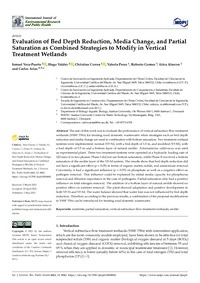Mostrar el registro sencillo de la publicación
Evaluation of bed depth reduction, media change, and partial saturation as combined strategies to modify in vertical treatment wetlands
| dc.contributor.author | Vera-Puerto, Ismael L. | |
| dc.contributor.author | Valdés-Riquelme, Hugo | |
| dc.contributor.author | Correa-Becerra, Christian | |
| dc.contributor.author | Perez, Valeria | |
| dc.contributor.author | Gomez, Roberto | |
| dc.contributor.author | Alarcon, Erica | |
| dc.contributor.author | Arias, Carlos | |
| dc.date.accessioned | 2021-12-30T14:58:46Z | |
| dc.date.available | 2021-12-30T14:58:46Z | |
| dc.date.issued | 2021 | |
| dc.identifier.uri | http://repositorio.ucm.cl/handle/ucm/3690 | |
| dc.description.abstract | The aim of this work was to evaluate the performance of vertical subsurface flow treatment wetlands (VSSF TWs) for treating rural domestic wastewater when strategies such as bed depth reduction and media change are used in combination with bottom saturation. Two treatment wetland systems were implemented: normal (VF-N), with a bed depth of 1.0 m, and modified (VF-M), with a bed depth of 0.5 m and a bottom layer of natural zeolite. Schoenoplectus californicus was used as experimental plant. These two treatment systems were operated at a hydraulic loading rate of 120 mm/d in two phases. Phase I did not use bottom saturation, while Phase II involved a bottom saturation of the zeolite layer of the VF-M system. The results show that bed depth reduction did not have a significant effect (p > 0.05) in terms of organic matter, solids, and ammonium removal. Conversely, it had a significant influence (p < 0.05) on phosphate as well as a negative effect on pathogen removal. This influence could be explained by initial media capacity for phosphorus removal and filtration importance in the case of pathogens. Partial saturation only had a positive influence on total nitrogen removal. The addition of a bottom layer of natural zeolite showed no positive effect on nutrient removal. The plant showed adaptation and positive development in both VF-N and VF-M. The water balance showed that water loss was not influenced by bed depth reduction. Therefore, according to the previous results, a combination of the proposal modifications to VSSF TWs can be introduced for treating rural domestic wastewater. | es_CL |
| dc.language.iso | en | es_CL |
| dc.rights | Atribución-NoComercial-SinDerivadas 3.0 Chile | * |
| dc.rights.uri | http://creativecommons.org/licenses/by-nc-nd/3.0/cl/ | * |
| dc.source | International Journal of Environmental Research and Public Health, 18(9), 4842 | es_CL |
| dc.subject | Nutrients | es_CL |
| dc.subject | Partial saturation | es_CL |
| dc.subject | Vertical subsurface flow treatment wetlands | es_CL |
| dc.subject | Zeolite | es_CL |
| dc.title | Evaluation of bed depth reduction, media change, and partial saturation as combined strategies to modify in vertical treatment wetlands | es_CL |
| dc.type | Article | es_CL |
| dc.ucm.facultad | Facultad de Ciencias de la Ingeniería | es_CL |
| dc.ucm.indexacion | Scopus | es_CL |
| dc.ucm.indexacion | Isi | es_CL |
| dc.ucm.uri | www.mdpi.com/1660-4601/18/9/4842 | es_CL |
| dc.ucm.doi | doi.org/10.3390/ijerph18094842 | es_CL |



